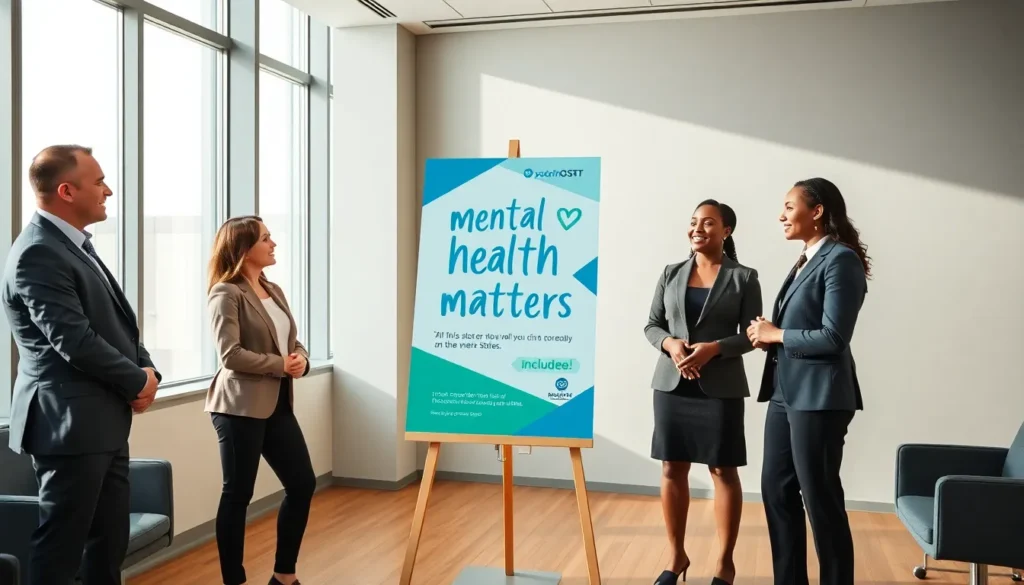In a world where stress often feels like a permanent resident in our lives, the importance of mental health cannot be overstated. Mental wellness isn’t just a trendy topic: it’s an essential pillar of overall health. To effectively communicate this crucial message, creating a “Mental Health Matters” poster can serve as a powerful tool. Not only does it raise awareness, but it also inspires individuals to prioritize their mental well-being. So, grab your favorite snacks, and let’s jump into the vibrant universe of mental health posters without turning into a snooze-fest.
Table of Contents
ToggleThe Importance Of Mental Health Awareness

Mental health awareness has gained significant traction in recent years, but the conversation is far from over. Many individuals still battle misconceptions and stigma surrounding mental health issues. In fact, research from the National Alliance on Mental Illness (NAMI) indicates that approximately one in five adults experience mental illness each year. Hence, it’s crucial to foster an environment where discussions flourish.
Effective mental health posters act as a visual cue to spark these necessary conversations. By featuring relatable content and inviting designs, they can help reduce stigma while promoting understanding. The impact of open dialogue around mental health cannot be underestimated: it can lead to earlier diagnoses, treatment options, and eventually, recovery. When awareness becomes a culture, everyone wins.
Key Components Of An Effective Mental Health Poster
Creating a mental health poster that resonates starts with understanding its essential components. Here are the fundamentals that make a poster effective:
- Compelling Message: First and foremost, a strong message grabs attention. This can include statistics that shock or inspire, quotes that resonate, or calls to action that urge people to seek help.
- Visuals: Pictures and graphics can often convey emotions better than words alone. Use relatable images or infographics that tell a story.
- Easy-to-Read Text: Font choice matters. Opt for fonts that are readable from a distance but also match the vibe of your message. Avoid cluttering the design: clarity is key.
- Accessibility: Make sure your poster reaches various community members by using inclusive language and diverse images, making everyone feel represented.
- Resource Information: Finally, don’t forget contact information for local mental health resources, hotlines, or websites that individuals can turn to for help.
Design Tips For Creating Visually Impactful Posters
Designing a visually impactful poster isn’t just about making it pretty: it’s about conveying a vital message effectively. Here are some tips:
- Color Psychology: Understand the emotions that different colors evoke. Blue can represent calmness and trust, while yellow may evoke happiness and positivity. Choose your color palette wisely.
- Typography: Combine different font sizes for hierarchy. Headlines should stand out, while supporting text provides necessary detail. Overly decorative fonts can be tricky, so simplify where possible.
- Balance and Alignment: A crowded poster can quickly lose its appeal. Maintain whitespace to create balance. Align elements neatly to guide the viewer’s eye naturally.
- Visual Flow: Arrange content in a logical sequence. This leads viewers smoothly from one item to the next, enhancing comprehension.
By carefully considering design elements, makers can ensure their message shines bright.
Incorporating Messaging That Resonates
Messaging is at the heart of mental health awareness posters. To ensure it resonates with intended audiences, consider these approaches:
- Personal Stories: Sharing testimonials or personal journeys can humanize the issue. People tend to connect more with real-life experiences than with abstract concepts.
- Inclusive Language: Use language that speaks to everyone, avoiding jargon or clinical terms that may alienate. Aim for empathy and understanding.
- Focus on Positivity: While it’s essential to highlight struggles, striking a balance with uplifting messages encourages hope and resilience.
- Call to Action: End with a call to action that tells viewers what they can do next, whether it’s seeking help, checking in on friends, or engaging in self-care practices.
How To Distribute And Promote Your Poster
Creating the perfect poster is just the first step. Getting it into the right hands is another story. Here’s how to maximize visibility:
- Community Centers: Start by placing posters in local community centers, libraries, and schools. This spreads messages where they are needed most.
- Social Media: Snap a high-quality image of the poster and share it across social media platforms. Use relevant hashtags to widen reach.
- Collaborate: Partner with local mental health organizations. They often have networks for sharing materials and can help get your voice heard.
- Digital Versions: Don’t forget to create a digital version of the poster for online sharing. Available downloads can also increase shareability.
By leveraging both community channels and digital platforms, one can effectively promote mental health awareness.
Case Studies: Successful Mental Health Campaigns
Successful mental health campaigns provide valuable lessons in poster effectiveness. Here are a few noteworthy examples:
- #StigmaFree: This campaign by NAMI featured posters that highlighted positive affirmations and prompted conversations around mental health, making the topic more approachable.
- Mental Health Awareness Month: The campaign emphasizes self-care and community support through visually appealing posters that have become a staple in schools and public spaces.
- Mind: This UK organization uses community-driven posters to advocate for mental health needs, ensuring representation across demographics while highlighting the importance of seeking help.
Each case reveals how effective messaging and visually engaging designs can break down barriers and foster supportive conversations.





